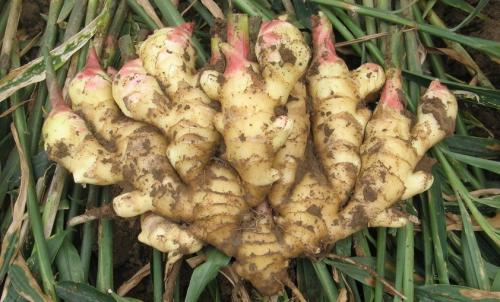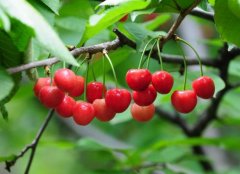How to grow ginger? Introduction to planting techniques of High-yield Ginger and topdressing and soil cultivation of Ginger
As the saying goes, "ginger is old and spicy". Ginger contains the most gingerol and is more pungent than tender ginger, so usually if you want to dispel cold, promote blood circulation, and remove fishy smell, it will usually be cooked with old ginger, and the effect will be good only if it is cooked with skin; as for other tender ginger and powdered ginger, which are not very hot, they are often used as an appetizer, or they can also be steamed and eaten. Where is the ginger suitable for growing?
(1) selected varieties of ginger
Ginger should be planted with fine varieties. At present, there are more than 20 varieties of ginger, such as Shandong Laiwu ginger, Guangzhou meat ginger, Anhui Linquan tiger ginger and so on. These varieties have strong adaptability and good high yield. Suitable varieties can be selected according to local natural conditions.
(2) to cultivate strong buds
1. Dry ginger and trapped ginger
The drying of ginger is usually carried out 20 seconds and 30 days before sowing. Sun ginger should be moderate, if the sun is strong at noon, straw mats can be used to shade the sun. Take it into the house in the evening to prevent the cold at night. After drying the ginger, the ginger seeds are placed in the house, covered with grass or old quilts, and stacked for 3 days, which is called "trapped ginger". Drying ginger and trapped ginger can increase the temperature of ginger pieces, promote the decomposition of internal nutrients, speed up germination, reduce moisture content of ginger pieces, and prevent ginger pieces from rotting.
2. Select
After drying ginger and trapped ginger, eliminate the thin, shrunken, browned and soft pieces of ginger. Choose strong ginger pieces with fat and plump, bright skin color, fresh meat, no shrinkage and no disease and insect pests as ginger seeds.
3. Accelerating budding
The ginger seeds were placed in an environment with a temperature of 20 ℃ and a humidity of 70 mi 80% to promote the rapid germination of ginger buds. Mostly before and after the sting. Open-field cultivation was postponed for 30 days.
(3) Land preparation
Jiang Tian should choose fertile soil with high topography, deep soil layer, rich organic matter, water and fertilizer conservation, soft ventilation and slightly acidic soil. Jiang Tian should not continue cropping. The selected ginger field should be ploughed 25 cm after harvest in autumn, weathered by rain and snow in winter, thawed in the first and middle March of the following year, and applied basic fertilizer combined with raking land: 5000,000 kg of rotten and high quality fertile fertilizer per mu, 30 kg of urea, 13 kg of diammonium phosphate, 50 kg of potassium sulfate, 1 kg of zinc sulfate and 0.5 kg of borax. In order to prevent underground pests, use 3% phoxim granules 2 kg mixed with soil 12-15 kg per mu. Then level the ground and rake it fine.
(4) sowing
Sowing at the right time is a prerequisite for high yield. In Huaibei area, plastic film cultivation is generally sown in the first and middle of April, while conventional cultivation is usually in early May and when the soil temperature is more than 15 ℃. It should be early rather than late in the suitable sowing time. Before sowing, soak the seeds in Bordeaux solution composed of quicklime, copper sulfate and water for 20 minutes. Then break up the large pieces of ginger seeds, and it is appropriate to use each piece of ginger 50Mel 75g. Generally, only one short strong bud is retained, a few pieces of ginger can retain two strong buds according to the bud condition, and the rest buds are all removed. When breaking ginger, if it is found that the base of the bud is blackened or the section of the broken ginger turns brown, it should be strictly removed. After breaking the ginger, dip the mouth in fresh, clean plant ash to seal the wound.
Water it once. Generally choose well water to irrigate. It is better to water in the morning or evening in summer. Drainage should be carried out in time on rainy days to ensure that there is no stagnant water in the ginger ditch.
(5) topdressing and soil cultivation
Ginger is a fertilizer-tolerant crop, which has a long growth period and needs a large amount of fertilizer, so it should be applied reasonably according to different growth periods. Before and after the Beginning of Autumn, ginger changed from seedling stage to vigorous growth period, and the demand for fertilizer and water increased obviously, so it was necessary to apply "turning point fertilizer". Generally, after removing the plastic film, 75 kg of cake fertilizer, 30 kg of urea, 10 kg of potassium sulfate, 0.5 kg of zinc sulfate and 0.25 kg of borax are applied per mu. Cover the soil to seal the ditch and cultivate ridges, so that the furrow of the original ginger plant becomes a ridge, and the ridge becomes a furrow. It is usually watered 2 days after fertilization.
In the middle of September, in order to ensure the nutrient needs of ginger rhizome expansion, "supplementary fertilizer" should be applied. Urea is applied to 7.5 kg of urea per mu. When topdressing, it can be applied in a small trench under the ridge, or the fertilizer can be dissolved in water and flushed with the water. Nitrogen, phosphorus, potassium formula fertilization, enhance plant disease resistance, strictly prohibit partial application of nitrogen fertilizer; fourth, timely ditch drainage to prevent stagnant water in the field. Chemical control of ginger anthracnose: it can be sprayed with 1000 times of methyl thiophanate wettable powder and 1000 times of 75% chlorothalonil, or 1000 times of 50% chlorothalonil, foliar spray at the beginning of the disease, once in 10 days, 2 times in a row.

- Prev

How do the West Indian cherries taste? Introduction to the Origin and use of West Indian Cherry
From the Northern Hemisphere of California Cherry, Northwest Cherry, followed by the Southern Hemisphere of New Zealand, Australia. The largest sources of domestic imported cherries are the United States, Canada and New Zealand and Australia, and the main producing areas of the United States are California and the northwest. Generally speaking,
- Next

What are the nutritional values of yellow / white / purple sweet potatoes? Differences in nutritional composition of yellow / white / purple sweet potatoes
Yellow, white, purple potatoes, what is the difference in nutrition, which is better? You can also learn about the time and method of planting sweet potatoes! According to the color of the root, the sweet potato can be roughly divided into white meat, yellow (orange, red).
Related
- The first cup of black tea in spring, the flavor and history of tea gardens in Kenya, Africa
- The computer can not only choose potatoes, but also grow tea rice. AI will grow winter oolong tea champion.
- It is not only the inflated tea bitten by insects, but also engraved with the four seasons tea in Beipu.
- The Oriental Beauty Tea Festival in Zhuxian County takes the stage at the weekend to experience the plus-size feast of oil tea.
- & quot; Oriental Beauty Tea & Exploration of Emei in Hsinchu, the hometown of quot;
- The new variety of strawberry "Tainong 1" dessert is the first choice with mellow aroma. Crimson gorgeous
- History of Tea in Taiwan: from Wild Inner Mountain to Export Tea Garden
- Two types of Taiwan Oriental Beauty Black Tea won the British three-Star Award for Childhood Tea Xiang Zhang Jiaqi changed from pilot to champion tea maker.
- Banana species and varieties: the planting history of Taiwan Xianren banana and dwarf banana is long, is banana disease resistant?
- Coffee planting Technology: Qianjie Coffee from Seedling to harvesting

